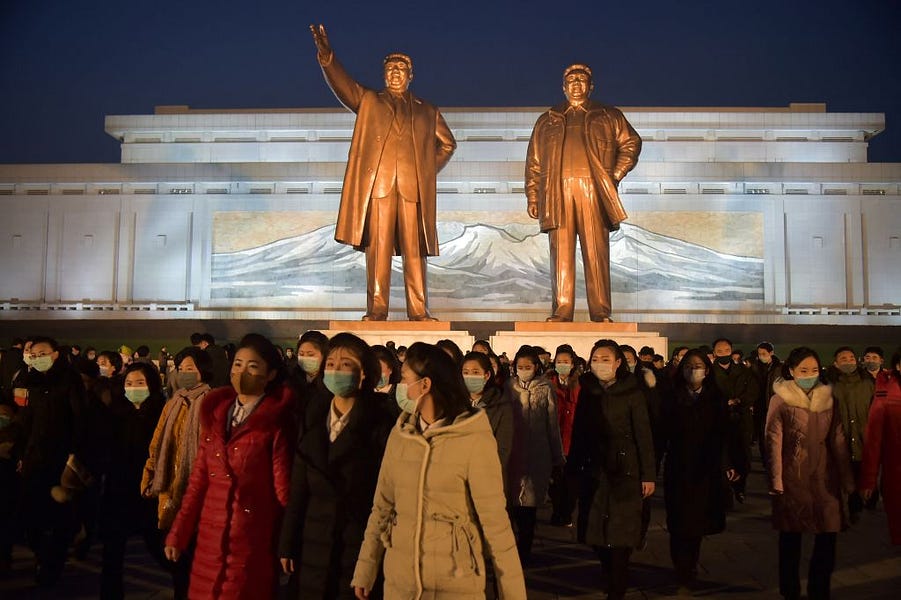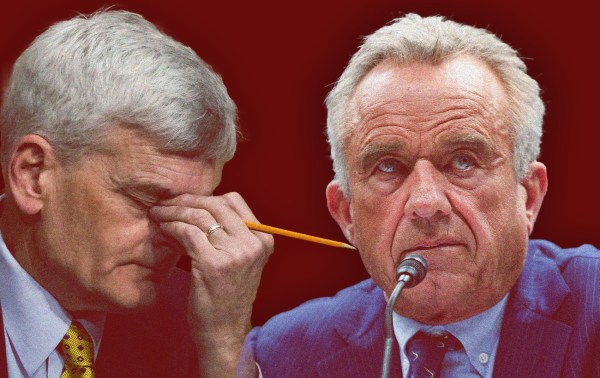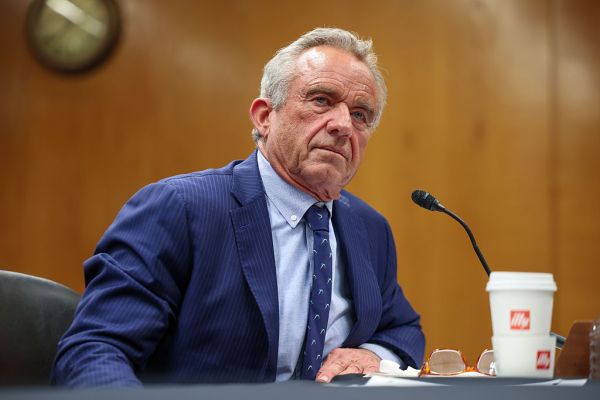It’s become a New Year’s tradition. Every January, North Korea watchers predict that the next 12 months will be a “crossroads year” because unique conditions make it unlikely that Pyongyang can survive in its present state. The regime, they argue, will either make irreversible policy reforms and diplomatic concessions or implode.
Yet, year after year, North Korea defies these predictions, ending the year very much the same as it began. The regime has repeatedly disappointed those predicting it was about to change its ways. Even when apparent dramatic shifts occurred, in retrospect, they seem part of consistent long-term trends.
While North Korea has been willing to alter its tactics, its objectives and strategy have remained consistent. This constancy does not bode well either for improving internal economic and political conditions for the citizenry or greater regime willingness to become less threatening and negotiate denuclearization.
The regime remains stable. Each North Korean dynastic leadership succession seemed fraught with failure. In both 1994 and 2011, it was postulated that neither Kim Jong-il nor Kim Jong-un could fight off the inevitable power struggles and coup attempts by those who felt more worthy to lead the country. In December 2011, some declared that North Korea as we knew it was over and Kim would be overthrown within six to 12 months.
However, the North Korean regime has shown remarkable resilience, belying repeated predictions of its imminent demise. Both leaders survived their successions as well as countless additional rumors of imminent regime collapse. The North Korean elite had a vested interest in maintaining the system while the pervasive and brutal security services eliminated any perceived opposition.
Kim Jong-il had been groomed for the role for decades and essentially ran the country for the last years of his father’s life before he officially assumed power in 1994. Although Kim Jong-un lacked similar long-term preparation, the regime implemented a leadership succession plan after Kim Jong-il’s 2008 stroke.
During the subsequent three years, Kim Jong-un was made a four-star general despite having never served in the military, and he was given leadership positions to control the military, government, and Korea Workers Party. After his father’s death, Kim Jong-un quickly showed he had full control of the reins of power.
Defying predictions of reform. In 1994, some experts predicted Kim Jong-il would be a bold economic reformer. North Korea, they said, was on the cusp of implementing massive economic reform. Black markets proliferated during the great famine of the mid-1990s, and the regime’s grudging acceptance of them was touted as burgeoning capitalism. Kim’s 2001 trip to Shanghai and his 2006 “Southern tour” of Chinese cities were hyped as harbingers of reform and opening the country.
Similarly, Kim Jong-un’s ascension to power in 2011 was greeted with forecasts of a brave new world in North Korea. After all, the new leader had been educated in Switzerland and was foreseen as being eager to transplant Western ideas of capitalism, reform, and openness—North Korean versions of perestroika and glasnost.
Kim Jong-un quickly displayed a mastery of public relations, patterning his manner and appearance on those of his grandfather Kim Il-sung, who is still much beloved by the North Korean populace. Shortly after assuming control, Kim attended a show with his nattily dressed wife watching Disney characters cavort on stage and clips of Rocky IV and Frank Sinatra. These were perceived as additional signals of forthcoming liberalization and a less provocative foreign policy.
However, Kim Jong-un has shown himself to be a chip off the old regime block rather than the predicted reformer. He has maintained the brutal and repressive policies of his dictatorial predecessors—indeed accelerating and intensifying many existing trends.
While there have been some changes to North Korea’s economy, the regime still extolls the virtues and necessity of a centrally controlled socialist economy. Indeed, Kim Jong-un has rescinded several initiatives that had initially appeared to loosen government control of some segments of the economy.
North Korea remains the Hermit Kingdom. Rather than opening his country to outside influence, Kim Jong-un doubled down on the harsh authoritarianism of his father and grandfather. Extensive purges before and after his father’s death enabled Kim Jong-un to assume control seamlessly. Hundreds of officials were removed to face punishment, torture, or death. Kim even had his uncle and half-brother executed; the latter was assassinated with the deadly nerve agent VX in a crowded civilian airport in Malaysia.
Kim tightened border controls to repress the flow of information to and from the outside world, which he deemed a threat to regime stability. In December 2020, Pyongyang enacted legislation to crack down on foreign content and influence in the country. It imposed harsh penalties, including the death penalty for distributing South Korean entertainment. Numerous people were publicly executed for possessing foreign films or TV shows. Citizens were forced to watch these executions in order to create an atmosphere of fear and compliance.
According to the 2014 U.N. Commission of Inquiry, Kim Jong-un continued the “systemic, widespread, and gross human rights violations” of his predecessors that constitute crimes against humanity. His regime is responsible for enforced disappearances, torture, violations of the freedoms of thought, expression, religion, movement, and denial of the right to food. Medical experimentation, forced abortions without anesthesia, and other atrocities take place in the vast gulag system.
Expanding nuclear and missile threat. Kim Jong-un oversaw an expansive diversification of North Korea’s arsenal and accelerated nuclear and missile testing upon assuming power. New weapons overcame the shortcomings of their predecessors and now pose a far greater threat to allied forces and cities. North Korea is producing a new generation of advanced mobile missiles that, in addition to being more accurate, more mobile, and more difficult to detect and target, have an enhanced ability to evade allied missile defenses.
During Kim’s tenure, North Korea conducted four of its six nuclear tests, including that of a hydrogen bomb at least 10 times more powerful than the World War II atomic bombs. Today, it may have 50 or more nuclear weapons. In 2017, Pyongyang demonstrated the ability to attack the continental United States by successfully testing two ICBM systems. In October 2020, the regime paraded a multiple-warhead ICBM that could overwhelm missile defenses of the American homeland.
Rejecting dialogue. Since the collapse of the U.S.-North Korean summit in 2019, Pyongyang has been dismissive of dialogue with Washington or Seoul. Following U.S.-North Korean working-level diplomatic meetings in October 2019, Pyongyang declared it had “no intention to hold such ‘sickening negotiations’” unless the United States substantially altered its policy. In March 2021, First Vice Foreign Minister Choe Son-hui announced the regime would have “no contact or dialogue of any kind” with the Biden administration and dismissed U.S. calls for complete denuclearization as “groundless rhetoric.”
The regime has repeatedly declared that it would never abandon its nuclear arsenal and affirmed that the country’s nuclear weapons are not “a political bargaining chip for getting U.S. dollars.” Pyongyang’s nuclear arsenal provides a “trusted shield” and “treasured sword” to support both defensive and offensive missions.
In 2020, Kim Yo-jong, Kim Jong-un’s powerful sister, urged the U.S. to abandon the “pipe dream” of getting the regime to agree to the permanent dismantlement of its Yongbyon nuclear facility in exchange for partial lifting of sanctions. If Washington wanted a resumption of bilateral negotiations, she said, it would have to put much more significant concessions on the table than it did in the Hanoi summit.
Kim Jong-un declared in early 2021 that, if Washington seeks dialogue, it must first abandon its “hostile policy.” Pyongyang insists that the U.S. abrogate the U.S.-South Korean alliance, remove all U.S. forces from the region, end all international sanctions, and cease any criticism of the regime. Then, he says, he’ll be open to talks.
Kim affirmed this message during the December 2021 plenum by making no mention of the United States and only a passing reference to inter-Korean relations. Kim indicated that North Korea was focused internally on solving its economic problems with little interest in the outside world. While the lack of bombastic threats was welcome, there was nothing in Kim’s message to suggest a resumption of dialogue or negotiations.
Bleak future ahead. North Korea faces dire economic conditions brought on by its failed socialist economic policies, international sanctions, and self-imposed COVID-related isolation from trading partners. Despite this, Pyongyang rejects offers of economic and humanitarian assistance and attempts at resuming diplomatic discussions.
The path to dialogue with North Korea has often followed an escalation of tensions and subsequent regime offers to return to the status quo ante … for a price. But Pyongyang has atypically eschewed conducting a major provocation in 2021, contrary to its history of doing so in the first year of a new U.S. administration. Perhaps it seeks to complete ongoing short- and medium-range missile programs prior to stirring the international hornets’ nest of retribution triggered by a nuclear or ICBM test.
The regime may have refrained from major provocations intended to force the U.S. to the negotiating table in a supplicant manner until COVID conditions allow face-to-face diplomatic meetings. Currently, North Korean officials overseas are precluded from reentering the country due to fears of COVID contagion. The lingering pandemic, including from the Omicron variant, will cause further deterioration of the economy as well as potentially further postponement of major provocations.
North Korea could eventually choose to conduct another nuclear test or launch any newly revealed long-range missiles, including a multiple-warhead ICBM or two large submarine-launched ballistic missiles. Doing so would plunge the Korean Peninsula back into a sense of crisis and necessitate international responses that could precipitate follow-on regime actions.
Kim’s decade in power reveals that he is not the reformer many had naively predicted he would be. Nor has he pursued a less belligerent foreign policy. Instead, Kim has proved to be even more brutal and repressive than his predecessors.
While rumors of ill health and regime instability will periodically arise, Kim Jong-un may well remain leader for decades to come. That is not good news for either the people of North Korea or the neighboring countries.
Bruce Klingner is the Heritage Foundation’s senior research fellow for Northeast Asia. He previously served 20 years with the CIA and Defense Intelligence Agency, including as CIA’s deputy division chief for Korean analysis.







Please note that we at The Dispatch hold ourselves, our work, and our commenters to a higher standard than other places on the internet. We welcome comments that foster genuine debate or discussion—including comments critical of us or our work—but responses that include ad hominem attacks on fellow Dispatch members or are intended to stoke fear and anger may be moderated.
With your membership, you only have the ability to comment on The Morning Dispatch articles. Consider upgrading to join the conversation everywhere.